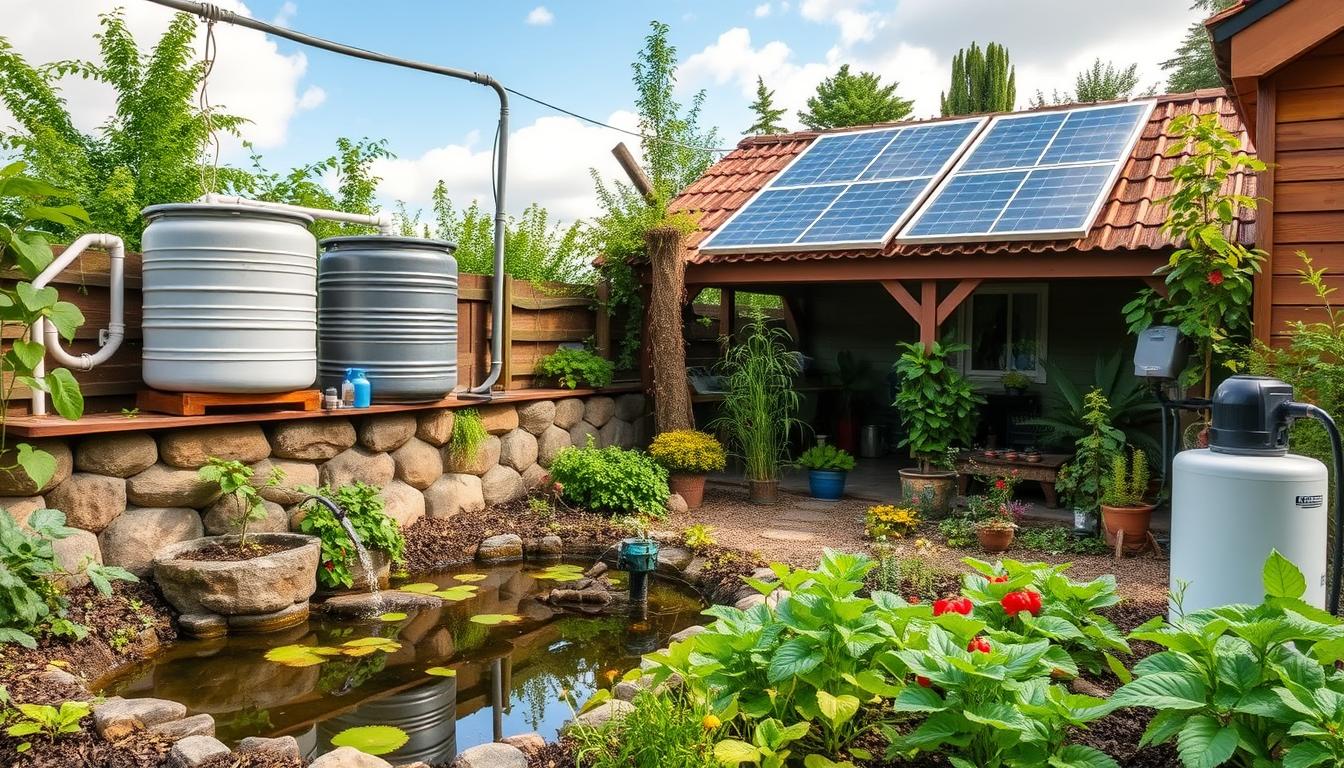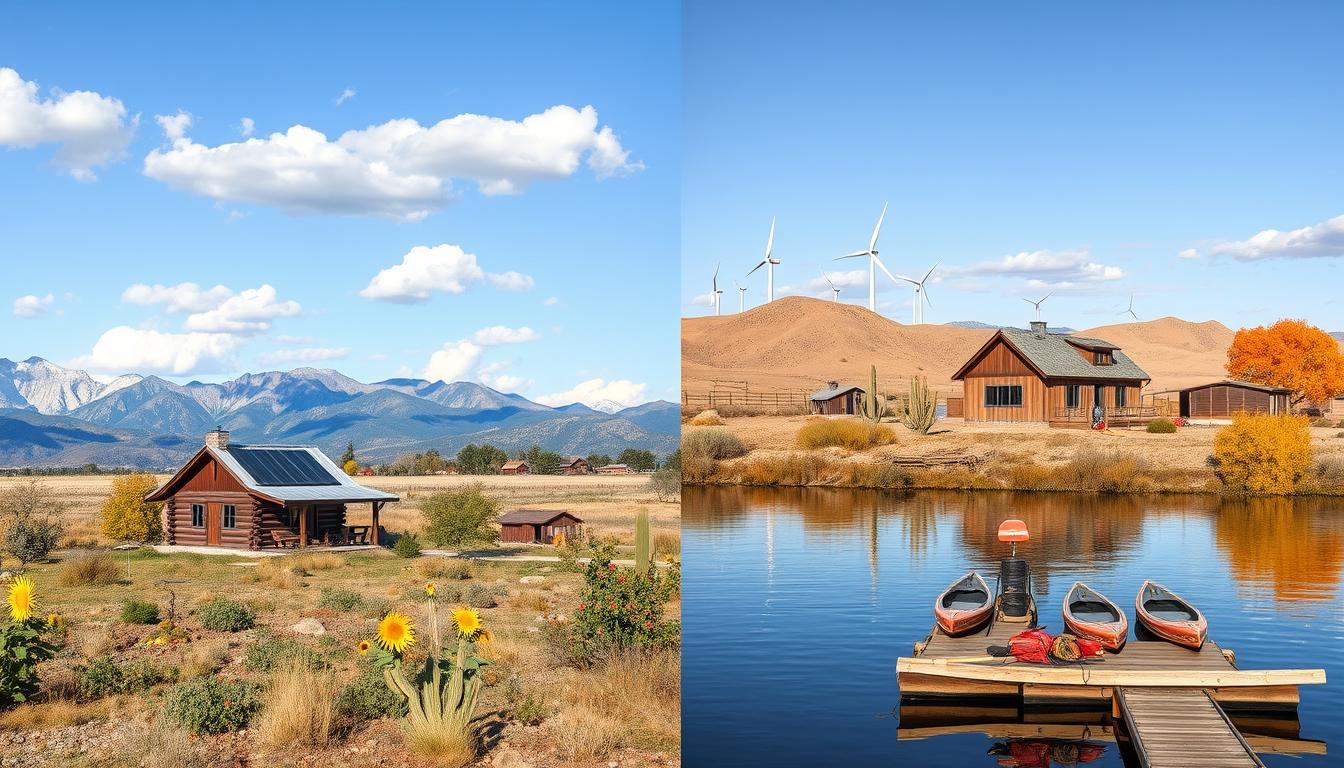More people are choosing to live off the grid for many reasons. They might want to be self-sufficient, reduce their environmental impact, or prepare for the future. This guide will show you the many renewable energy options out there. It aims to help you pick the best ones for your off-grid home.
Key Takeaways
- Discover the benefits of off-grid living and the pursuit of self-sufficiency.
- Explore the versatility of solar power and its practical applications for homesteads.
- Learn about harnessing wind energy to meet your home’s power needs.
- Uncover the potential of hydroelectric and geothermal systems for off-grid living.
- Understand the role of biomass and biofuel options in a renewable energy strategy.
- Discover how to integrate multiple renewable sources for a comprehensive energy solution.
- Prepare for off-grid living with a thorough understanding of the available renewable options.
What is Off-Grid Living?
Off-grid living means living away from the main power grid, often in places far from cities. It’s about being self-sufficient and helping the planet by using renewable energy. People choose this life to live off the land and use less fossil fuels.
Embracing Self-Sufficiency
Living off-grid is all about being self-sufficient. People make their own energy with solar, wind, or hydro power. They grow their food, collect rainwater, and handle their waste. This way, they depend less on the outside world.
Reducing Environmental Impact
Off-grid living is good for the planet. It uses clean energy and sustainable ways to live. This cuts down on fossil fuel use and lowers harmful emissions. It’s a green choice for those wanting to live better.
“The freedom of living off-grid is unparalleled. It’s not just about being self-sufficient, but also about being in harmony with the natural world around us.” – Jane Doe, off-grid living enthusiast
Off-grid living lets people live closer to nature and be more eco-friendly. It’s gaining fans as more people look for ways to live sustainably. This lifestyle is perfect for those wanting to break free from traditional power grids and live greener.
Harnessing Solar Power
Living off the grid often means using renewable energy, like solar power. This is a great choice because it’s easy to get and good for the planet. Solar energy can be a steady and green way to power homes.
Solar Panel Installation
Putting solar panels up right is important to get the most energy from them. Homeowners should think about where to put the panels, how they face, and the design of the system. It’s best to put panels in a sunny spot with little shade. Also, make sure they face the sun all day.
Solar Battery Storage Systems
Solar battery storage is key for off-grid living to keep the power going without interruption. These systems save the energy from the solar panels for when it’s not sunny. Getting good solar batteries means having a dependable backup power source. This makes homesteaders more independent.
“Solar power is a game-changer for off-grid living, providing clean, renewable energy that can be harnessed and stored for use whenever it’s needed.”
By planning and installing solar panels and solar battery storage well, off-grid homesteaders can use the sun’s power. This helps them meet their energy needs and lessen their environmental impact. It’s a big part of living on their own and cutting down on carbon emissions.
Wind Energy for Homesteads
For those living off the grid, wind energy is a great way to power their homes. It uses the wind to make clean, sustainable electricity. This helps reduce the need for fossil fuels.
Wind energy is reliable, working day and night. It’s perfect for off-grid homes in rural areas. This makes it a top choice for those wanting to be self-sufficient.
When adding wind turbines to an off-grid setup, several things must be thought about. These include where to put the turbine, its size, and how it works with other energy sources. Planning well is key to getting the most out of the system.
- Site Selection: Picking the best spot for a wind turbine is vital. Homesteaders should look at wind patterns, the land’s shape, and any things that might block the turbine.
- Turbine Size: Choosing the right size turbine is important. It affects how much power it makes. Things like how much energy you use, the space you have, and your budget should guide your choice.
- Integration with Other Renewables: Wind energy can work well with other sources like solar power. This mix makes sure you have power even when the wind or sun isn’t strong.
“Wind energy is a powerful and sustainable solution for off-grid living. By harnessing this natural resource, homesteaders can achieve greater self-sufficiency and reduce their environmental impact.”
By thinking about these things and adding wind energy to their setup, homesteaders can make the most of this green power. This boosts their energy independence and helps the planet.

Hydroelectric Power Potentials
For off-grid homesteads near a stream or river, hydroelectric power is a great choice. It uses the power of water to make electricity and supply water. This section looks at how micro-hydro systems and hydro-ram pumps can help.
Micro-Hydro Systems
Micro-hydro systems are perfect for small-scale power needs. They use flowing water to make clean, green electricity. These systems are good for the planet and help homesteaders be self-sufficient.
Hydro-Ram Pump Applications
Hydroelectric power can also run hydro-ram pumps. These pumps use water’s energy to move water up, giving off-grid homes a steady water supply. They’re easy to keep up, strong, and can work all the time. This makes them great for homesteaders wanting a green water source.
Using hydroelectric systems helps off-grid homes use less fossil fuel and grid power. It’s a big step towards being energy independent and eco-friendly.
“Harnessing the power of flowing water is a game-changer for off-grid living, providing a reliable source of renewable energy and water supply.”
Renewable Options for Off-Grid Living
Living off-grid means you have many ways to use renewable energy. You can use the sun’s power or the wind’s breeze. These green solutions help power your home and cut down on traditional energy use.
Solar power is a top choice for many. Solar panels give you steady electricity. Solar battery storage systems let you save extra energy for cloudy days. This makes solar energy a great pick for off-grid living.
Wind energy is another great option. With wind turbines in the right spot, you can turn wind into electricity. It takes some planning and setup, but it’s worth it for off-grid homes.
If you have water that moves, think about hydroelectric power. Micro-hydro systems and hydro-ram pumps use water’s energy. They make electricity and give you a steady water supply.
Looking into these renewable energy sources, off-grid homesteaders can live more sustainably. They lessen their environmental impact and improve their life quality.
“The future of energy is renewable, and the future of living is off-grid.” – Anonymous
Geothermal Heating and Cooling
For those looking at self-sufficient, eco-friendly living, geothermal energy is a big step forward. It uses the earth’s stable deep temperatures for heating and cooling homes off the grid. This makes it a green choice.
Ground-Source Heat Pumps
Ground-source heat pumps are key to geothermal systems. They use the earth’s steady temperatures to move heat around. Unlike traditional systems that use fossil fuels, these pumps use the earth to heat and cool homes without harming the environment.
These pumps work by moving a water solution through underground loops. The loops take in or give out heat as needed. This method is very efficient, needing much less energy than traditional systems.
“Geothermal energy is a game-changer for off-grid living, offering a clean and sustainable solution for heating and cooling our homes.”
For homesteaders and those living off the grid, ground-source heat pumps are a smart choice. They use geothermal energy under their feet. This cuts down on fossil fuel use and keeps homes comfortable all year while being kind to the planet.

The need for renewable energy is growing, and ground-source heat pumps are becoming a top pick. They offer a way to be energy independent and live more sustainably.
Biomass and Biofuel Options
Solar, wind, and hydroelectric power are top choices for off-grid living. But biomass and biofuel are also great options. They offer warmth, power, and fuel for those wanting to be self-sufficient and eco-friendly.
Wood-Burning Stoves
Wood-burning stoves are a key biomass choice for off-grid homes. They heat spaces well, cutting down on the need for fossil fuels. By using local wood, like fallen branches or sustainably cut timber, homesteaders can lessen their energy reliance.
Biodiesel Production
Producing biodiesel is another biofuel choice for off-grid living. Homesteaders can turn used vegetable oils or animal fats into a clean, renewable fuel. This not only cuts down on waste but also offers a green alternative to regular diesel.
Adding biomass and biofuel to their energy sources, off-grid homesteaders can boost their self-sufficiency and lower their carbon footprint. Wood stoves and biodiesel production are practical, sustainable ways to power and heat homes.
“Embracing biomass and biofuel options can be a game-changer for off-grid living, providing renewable and self-sufficient energy solutions.” – Sarah Johnson, Sustainable Living Expert
Integrating Multiple Renewable Sources
For homesteaders wanting energy independence and resilience, using many renewable energy sources is key. By mixing solar, wind, and hydroelectric power, off-grid living gets more reliable and flexible.
Hybrid Energy Systems
Hybrid energy systems use different renewable sources to create a full and balanced power solution. This way, if one source is down, others can keep the power flowing. Homesteaders can design their systems to fit their energy needs and the land they have, making them more efficient and self-sufficient.
Hybrid energy systems have many advantages. They offer better energy security, cut down on fossil fuel use, and can lower energy costs over time. Also, combining renewable tech makes off-grid living more resilient and adaptable. This means homesteaders can handle seasonal changes and power outages easily.
By going for hybrid energy systems, homesteaders can achieve a new level of energy freedom and green living. They get to enjoy the perks of off-grid living too.
Conclusion
This article has shown us the many ways to use renewable energy and live off the grid. Solar panels and wind turbines are just the start. They let us use nature’s power to be self-sufficient and protect the environment.
There are many ways to get renewable energy on a homestead. We can use water flow for power or earth’s heat. By combining different sources, like solar and wind, we can make our off-grid life strong and green.
Choosing off-grid living and renewable energy is a big change. It means we care about the planet, want to be independent, and value energy freedom. As more people start this path, the future of off-grid living looks bright with renewable energy.







